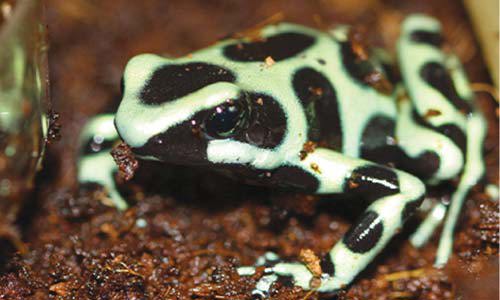Appearance:
Poison dart frogs vary in color, though most are black, green, or light blue with black bands or spots. Their skin is slippery and moist. Males have a barely distinct wrinkled vocal sac under the skin of their throat. These frogs have poison glands on the surface of their body, and they capture prey using their sticky, retractable tongues and keen eyesight. Their bright colors are believed to discourage predators, and bold contrasting patterns may warn predators who have no color vision.
Size:
Adults are about 4 centimeters (1.57 inches) long; males are slightly smaller and slimmer than females.
Diet:
Frogs prey on small invertebrates, and they get their toxicity from the foods they eat. Frogs can sequester high quantities of alkaloids from ants and insects that they eat in their skin; these alkaloids makes the frog poisonous.
Behavior:
Diurnal, dart frogs are seldom still during the day, constantly searching for food and caring for their young.
Reproduction:
Mating season takes place throughout the entire rainy season of the rainforest, from mid-July through mid-September. Males fight among themselves to establish territories, which then remain fixed for the rest of the mating season. The male frog conducts an elaborate mating ritual, and he attracts a female with vocalizations consisting of trilling sounds. Calling and courtship seem to be limited to ground level. Part of the mating behavior involves the frogs rubbing against one another.
When courtship is complete, the female lays up to six eggs in a small pool of water. A gelatinous substance encases the eggs for protection from predators. During the two-week development stage, the male frog returns periodically to check on the eggs. Once tadpoles hatch, they climb onto the male’s back, attached by a mucous secretion, and he carries them to a place suitable for further development such as a lake or stream. Tadpoles reach adulthood in another six weeks.
Habitat/Range:
Poison dart frogs can be found in Central and South America, from Nicaragua and Costa Rica to southeastern Brazil and Bolivia. They were introduced in Hawaii by humans and have flourished there. Adults are found on the rainforest floor. They prefer locations near small streams or pools, where tadpoles can safely develop.
Fun Facts:
- Poison dart frogs are also known as poison arrow frogs because hunters living in the rainforest used the frogs’ skin toxins on their darts and arrows.
- There are over 100 different kinds of poison dart frogs.
- Scientists are investigating the potential of one of the frogs’ toxins, epibatidine, for use as a powerful new painkiller that may have the benefits of morphine without its damaging side effects. An extract from the frog's skin has been shown to block pain 200 times more effectively than morphine.
- The frogs’ toxicity comes from the ants or other insects they eat in the wild. Captive-bred poison dart frogs are not toxic due to their different diet.


